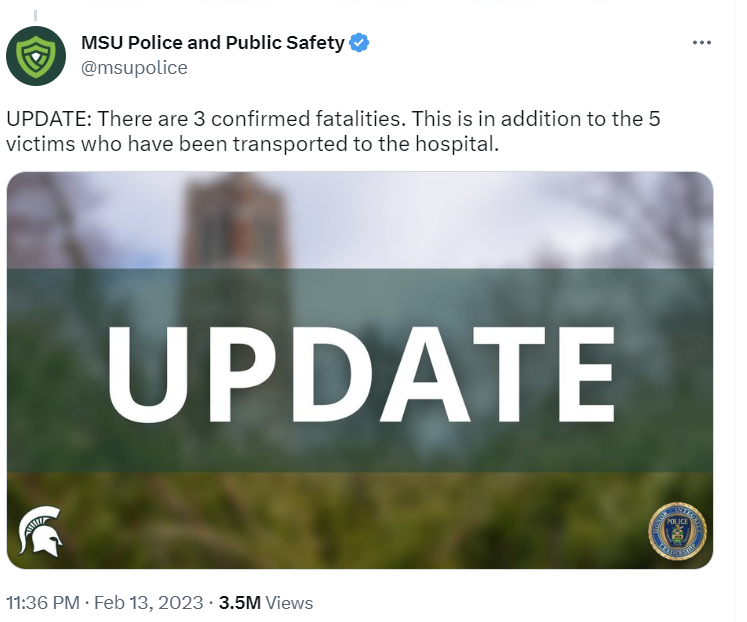Michigan State: Real-Time Comms Test
A week ago, Michigan State experienced a horrifying night, as a shooter roamed the campus, leaving three students dead and five critically wounded.
Sadly, one word that cannot be used to describe the event is “unthinkable.” Every university in the country understands that this could happen to them.
I followed the event live, and I thought MSU handled it flawlessly. When something comes off that smoothly, it has to be well-planned and prepped. This is especially important for Michigan State, which has a complicated set of jurisdictions, including Campus Police, Lansing and East Lansing…as well as the State Police in the state capitol.
Social Media the Perfect Crisis Tool
The overall utility of social media is highly in doubt. Having said that, there may be no area where it is more useful than in an unfolding crisis like this one. MSU was able to use its Twitter feed as a canonical source of information. Before that, information would have to be sent to the media and they would have to relay it—which is possibly less accurate and less timely. (For example, at least twice MSU made an important announcement that CNN did not get to for 5 minutes while some “expert” with no knowledge of the situation jabbered on.)
We used to recommend dark sites for this communication, but getting people to go to the site would be a struggle…as opposed to using Twitter, which also offers notifications.
I Observed Four Practices that Crisis Communicators Can Learn from MSU
Social media is also the source of a lot of misinformation. You are trying to keep panic down—you don’t want people leaving their shelter and racing around campus while a shooter is still loose. Clarity, control, and structure are your friends in avoiding panic. Confusion is your enemy.
Transparency in Action
For example, they announced that the death toll had increased from 1 to 3 proactively and before anyone else had it. This is something that did not have to come out while the situation was “active,” but MSU established its credentials as a trusted source of information. (Note also the clarity. It was known five people had gone to the hospital, so the tweet makes it clear the three casualties are in addition to those in the hospital.)
2. Real-time Updates to Relieve Pressure
They took the pressure off by closing the campus and canceling events for 48 hours. Not only did this forestall parents racing to the campus, but it also told everyone they would not have to be on campus until it was safe. Again, this could have been announced after the active situation was over, but doing it mid-stream set the right tone.
3. Strong Briefings with Structured Updates
They did a good job with the briefings. One of the things you see in the successful management of crises is that briefings are held regularly and on a schedule. The best practice is to close one briefing by saying you will be back in one hour…or whatever time frame. Way less effective is to say “we will be back when we know more.”
4. Say “Don’t Know” When You Don’t Know
I thought the Deputy Chief did a good job with the briefings. He was very nervous (understandably) but you can also see false (Dubya Bush) bravado in those situations that rings untrue. When there was something that was unknown, he had the courage to say so. Everyone except the media in the room gets it.
Last Thoughts on MSU Crisis Comms:
Want to see the power of information? It was 17 minutes between the picture going out and the thing being over.
It was a bad night for the CNN announcer who seemed out-of-touch with campus life, wondering what event had students on campus at 8 pm and how the killer got access to the buildings he got in. (uhhh, night classes and they were all unlocked).
One thing you didn’t see was other communications with key stakeholders. I’m sure it was going on. For example, what about cafeteria workers who would need to come to campus to feed students over 48 hours…or scheduled deliveries? A solid crisis plan such as in Resilient5 looks at all relevant stakeholders, builds trust with them proactively, and spells out the key steps.
I also felt that the University did a good job keeping the briefings “operational” until it was over. By keeping the politicians out, they showed a commitment to safety, not “face time.”

